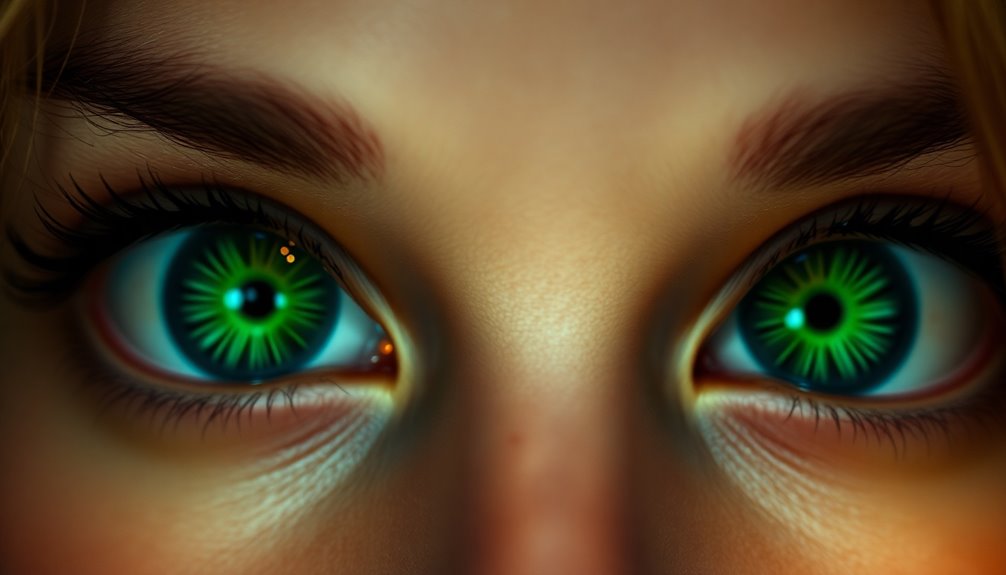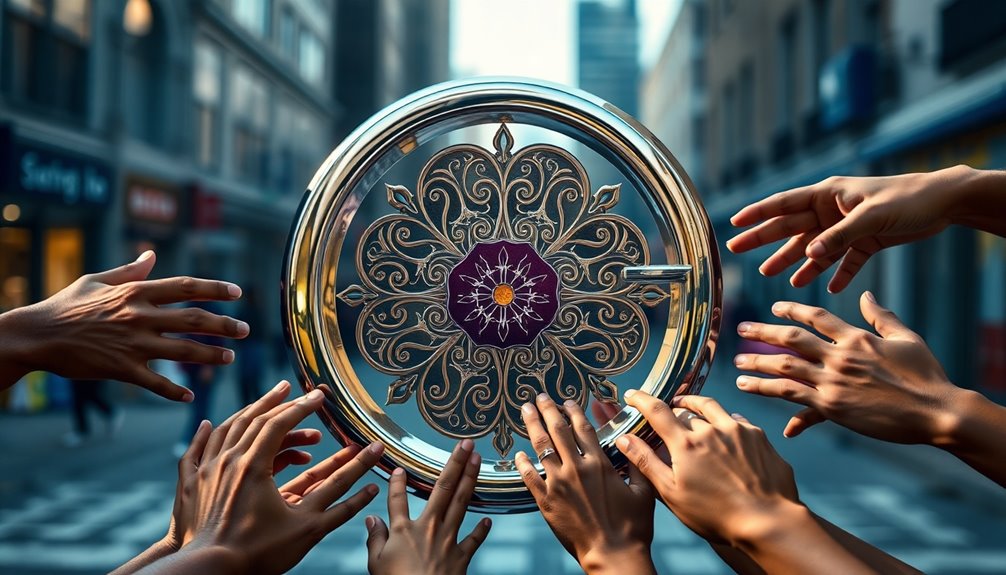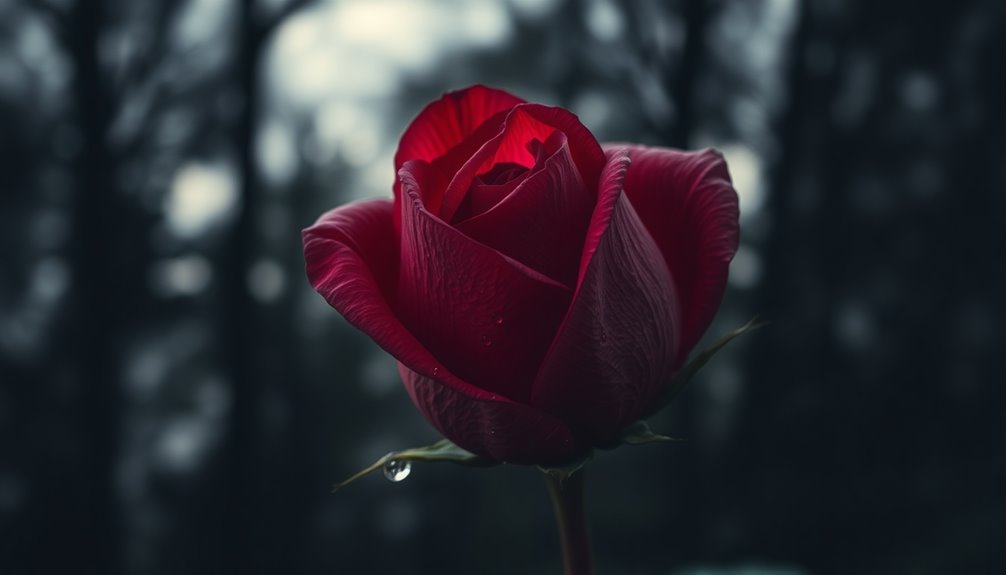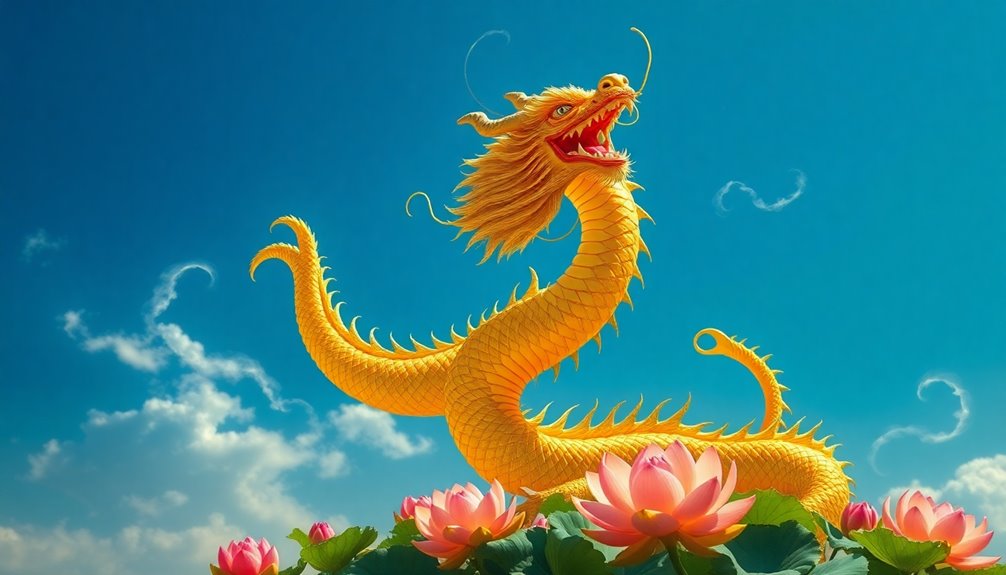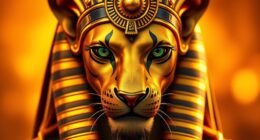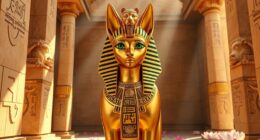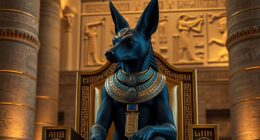A white dragon symbolizes purity and serves as a divine guardian in mystical domains. You'll find it embodies higher consciousness, guiding you on spiritual journeys. This majestic creature represents hope, acting as a protector against darkness while enhancing your creativity and personal growth. Cultural myths often depict white dragons as fierce protectors in battles and as keepers of ancient wisdom. Their serene energy promotes emotional healing, encouraging you to embrace hidden knowledge. By connecting with this powerful symbol, you can ignite your transformation. There's so much more to discover about white dragons and their influence in your life.
Key Takeaways
- White Dragons symbolize purity and spiritual awakening, guiding individuals on their spiritual journeys with clarity and higher consciousness.
- They embody protective energies, acting as guardians against darkness and ensuring access to sacred knowledge for the worthy.
- In various cultures, White Dragons are seen as symbols of hope, bridging the earthly and celestial realms in creation myths.
- Their presence fosters emotional healing and inspires creativity, enhancing artistic expression and personal transformation through shared experiences.
- By connecting individuals to nature and promoting mindfulness, White Dragons encourage profound personal growth and empowerment.
Symbolism of White Dragons

The symbolism of White Dragons evokes a sense of purity and spiritual awakening, drawing you into spheres of higher consciousness. These majestic beings embody white dragon energy, representing clarity and the transformative power found within spiritual journeys. When you encounter the essence of a White Dragon, you're reminded of ancient wisdom that guides you toward self-discovery and enlightenment.
White Dragons stand as protectors and guides, merging various spiritual elements to aid your quest for authenticity. Their presence signifies hope, pushing you to combat the darkness in your life while embodying divine authority.
As you connect with this symbolism, you might notice a surge in creativity and artistic expression, as White Dragons enhance your skills through their guidance.
The transformative energy of the White Dragon encourages you to explore areas of pure creation, fostering a sense of community and collective benefit. This powerful symbolism inspires you to embrace your true self, igniting a profound spiritual awakening that leads you to a higher understanding of existence.
Ultimately, the White Dragon serves as a beacon of purity, illuminating your path toward transformation and higher consciousness.
Cultural Significance and Myths

Throughout various cultures, the White Dragon holds profound significance, often seen as a symbol of purity and spiritual awakening. These mythical creatures embody higher dimensions of consciousness and serve as powerful guardians in mystical narratives.
White dragons are often depicted as protectors in battles against evil, reflecting their spiritual significance and divine authority.
In many cultural depictions, the White Dragon plays an essential role in creation myths, merging spiritual and earthly elements. This dragon symbolism represents both the Breath of Life and the Womb of Creation, showcasing its transformative nature.
In Japanese culture, for example, the White Dragon is revered as a water deity, closely linked to agricultural fertility and the protection of land and people. Its association with water further emphasizes its role as a life-giving force.
Moreover, myths surrounding the White Dragon often highlight the duality of Yin and Yang, illustrating its function as a bridge between terrestrial and celestial domains.
As you explore these rich narratives, you'll discover how the White Dragon continues to inspire awe and reverence across different cultures.
White Dragon Spiritual Meanings

White Dragon symbolism goes beyond cultural narratives, offering deep spiritual meanings that resonate with personal transformation and growth. When you connect with the white dragon, you tap into a profound spiritual symbolism that embodies purity, clarity, and awakening. This powerful dragon serves as a guardian and guide in your spiritual journeys, helping you navigate the complexities of self-discovery.
The white dragon's presence often signifies the duality of Yin and Yang, harmonizing protective and creative energies within you. It encourages you to embrace the hidden wisdom of your experiences, allowing you to evolve and gain insight into your life's purpose.
As you commence on your spiritual journey, the power of the dragon inspires artistic expression and enhances your creative potential.
In various mythologies, white dragons are depicted as protectors of sacred knowledge, symbolizing divine authority and emotional healing. By inviting the white dragon into your life, you open yourself to transformative experiences that foster personal growth and deepen your connection to the universe's creative forces.
Embrace this powerful ally, and watch as it illuminates your path toward enlightenment.
Creative Expressions and Healing

When you connect with the energy of White Dragons, you might find a surge of inspiration for your art and writing.
This creative spark not only fuels your expression but also acts as a pathway for healing, allowing you to process emotions and experiences.
Art and Writing Inspiration
The ethereal presence of White Dragons serves as a profound wellspring of inspiration for artists and writers alike. When you connect with these magnificent creatures, you tap into higher vibrational energies that enhance your creative flow and spiritual expression. Many have reported that their daily writing practices flourish after such encounters, igniting a powerful sense of artistic inspiration.
Here are some ways White Dragons can elevate your creative pursuits:
- Catalyst for Creation: Their energy encourages exploration of pure artistry, pushing you to hone your skills.
- Transformative Journeys: Engaging with White Dragons can lead to deep spiritual experiences, fostering a sense of gratitude and connection.
- Co-Creation: These dragons invite collaboration between human creativity and their mystical essence, benefiting not just you but the collective.
As you embrace the healing energies of White Dragons, you'll find yourself inspired to create works that resonate on a deeper level. This partnership not only enriches your own life but also contributes to the healing of others.
Allow the White Dragons to guide you on your artistic path, and watch as your creations flourish.
Healing Through Creative Expression
Harnessing the transformative power of creative expression can lead to profound healing, especially when inspired by the energy of White Dragons. These mystical beings encourage you to channel your emotions through art, writing, and music, allowing you to create works that resonate deeply within you. Engaging in creative endeavors not only fosters a sense of artistic purpose but also enhances your daily routines, encouraging a flow of inspiration. Moreover, the practice of emotional branding can amplify the impact of your creative expressions, forging deeper connections with your audience. Additionally, incorporating project-based learning can provide structured opportunities for creative exploration, further enriching the healing process.
Here's a quick look at how creative expression ties to healing through White Dragon energy:
| Aspect | Description | Benefits |
|---|---|---|
| Healing | Provides emotional release and clarity | Reduces stress and anxiety |
| Creative Expression | Channels feelings into art, writing, or music | Fosters personal growth |
| Collaborative | Encourages shared experiences in art groups | Strengthens community bonds |
Collaborative Creative Communities
In collaborative creative communities inspired by White Dragons, individuals tap into a shared energy that fosters artistic expression and healing.
These vibrant environments encourage you to explore your creative potential while connecting with the mystical essence of White Dragons. Through group activities like writing, painting, and music creation, you enhance your spiritual journeys and harness healing energies.
Consider the benefits of participating in such communities:
- Shared Inspiration: Collaborating with others allows you to exchange experiences and insights, deepening your understanding of dragon symbolism.
- Supportive Atmosphere: These communities validate your feelings and connections, promoting personal growth and enhancing the creative process.
- Collective Healing: The integration of White Dragon symbolism in your artistic expressions acts as a conduit for healing, fostering unity among members.
As you engage with these creative communities, you'll find that your artistic endeavors resonate with the transformative energy of White Dragons.
This unique blend of collaboration and creativity not only nurtures your individual talents but also cultivates a deeper sense of connection and purpose in your life.
Embrace the magic of these communities and let your creativity soar!
Guardianship and Protection Roles

When you think of White Dragons, consider them as powerful symbols of divine protection and spiritual guidance.
They guard sacred knowledge and offer support during your journey through life's challenges.
With their wisdom, these majestic beings help you navigate emotional turmoil and inspire personal growth.
Symbol of Divine Protection
What Does a White Dragon Symbolize? The Pure Guardian of Mystical Realms!
Symbol of Divine Protection (Guardianship and Protection Roles)
White Dragons stand out as powerful symbols of divine protection, embodying the essence of guardianship across various mythologies. They represent a beacon of hope, standing resolute against malevolent forces and ensuring safety for those in need.
When you think of White Dragons, consider their crucial roles in the spiritual domains:
- Protectors of Sacred Knowledge: They guard ancient wisdom and truths, ensuring that only the worthy uncover them. Their role is similar to the importance of quality sleep, which enhances cognitive function and emotional regulation. This notion resonates with the idea of mental well-being, emphasizing how protection and knowledge contribute to a fulfilling life. Just as essential oils for toothache relief can provide comfort and healing, White Dragons offer protection from harmful energies. Additionally, their commitment to safeguarding knowledge reflects the value of continuous learning in personal development.
- Illuminate the Path: With wings that radiate light, they guide seekers toward spiritual enlightenment and clarity.
- Defenders of the Broken-Hearted: Their presence offers comfort and safety to those who feel vulnerable, reinforcing the message of divine protection.
- Their serene energy is akin to mindfulness practices that promote tranquility and enhance emotional stability.
Spiritual Guidance and Support
The presence of a White Dragon in your life can signify powerful spiritual guidance and support, acting as a guardian on your journey. These majestic beings embody protective energy and serve as pure guardians, watching over you as you navigate life's challenges. Their wisdom encourages self-discovery and inner transformation, guiding you toward a deeper understanding of yourself.
When you face emotional turmoil, the White Dragon offers reassurance and emotional support, creating a safe space for healing. This connection fosters a sense of belonging, reminding you that you're never alone on your path.
You might find that their influence sparks creative inspiration, urging you to tap into your artistic talents and share your gifts with the world. As you embrace their guidance, you'll feel empowered to harness your creativity for the benefit of others.
This connection to the White Dragon not only enhances your personal growth but also encourages you to uplift those around you. Trust in their protective presence, and let them illuminate your journey with clarity and purpose, transforming your experiences into opportunities for growth and expression.
Guardians of Sacred Knowledge
Guardians of sacred knowledge, White Dragons play a significant role in protecting and preserving ancient wisdom.
These majestic beings embody divine wisdom, offering guidance and protection to those who seek enlightenment. As you commence your spiritual journeys, they safeguard the teachings and truths that can lead to profound insights and cosmic secrets.
White Dragons assist you in steering through the complexities of existence, guaranteeing that only the worthy access sacred knowledge. Their presence encourages you to embrace transformation and renewal, shedding illusions to uncover deeper truths.
In this process, you find:
- Purity and Clarity: They symbolize the importance of maintaining integrity and authenticity in your quest for wisdom.
- Spiritual Growth: Their guidance fosters personal growth, helping you evolve on your spiritual path.
- Protection of Knowledge: White Dragons guarantee that ancient teachings remain safe from those who'd misuse them.
Connection to Higher Realms
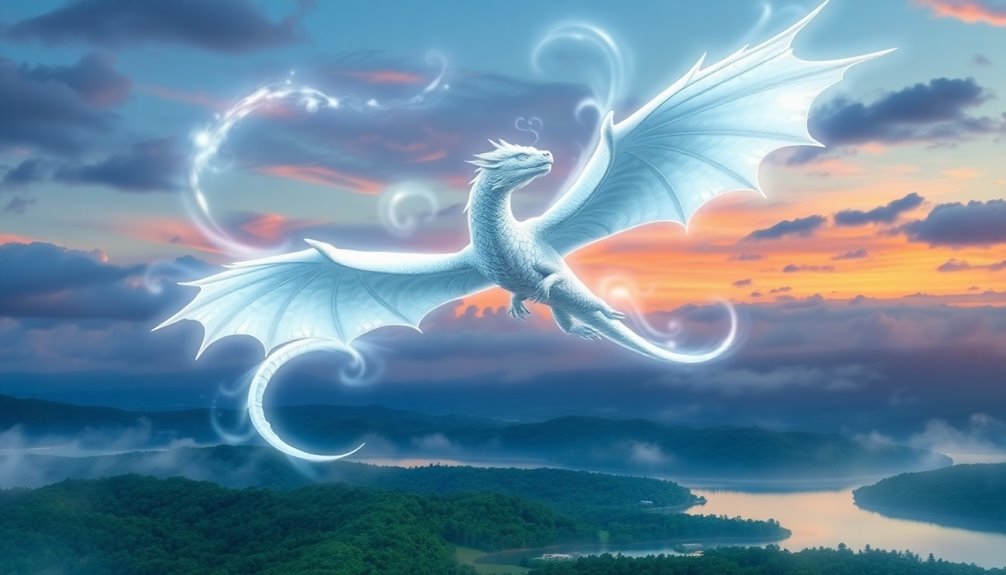
Many people find that the White Dragon serves as a powerful symbol of connection to higher spheres of consciousness and spiritual awakening. This majestic creature embodies clarity and purity, guiding you on your journey toward enlightenment.
As you embrace the energy of the White Dragon, you tap into a protective force that enhances your connection to higher dimensions and dimensional energies.
Moreover, the White Dragon encourages you to explore your creative expression, reminding you that art and writing are essential parts of your spiritual path. By merging various spiritual elements, it inspires you to channel your creativity into meaningful endeavors.
The cyclical nature of existence is also reflected in the figure 8 patterns associated with the White Dragon, emphasizing the infinite possibilities available to you.
When you encounter the White Dragon in your spiritual practice, consider it a significant call to probe deeper into your higher purpose. It invites you to recognize the importance of your spiritual awakening and the role it plays in your life.
Embracing this connection can lead to profound personal growth and a richer understanding of your place in the universe.
Dragon Energy and Transformation
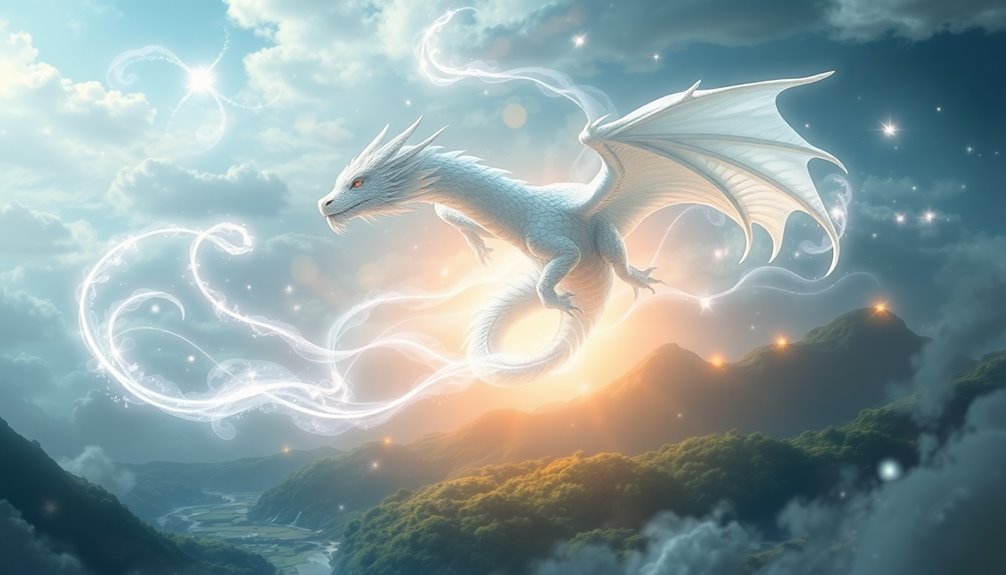
Harnessing dragon energy can ignite profound transformation within you, serving as a catalyst for personal growth and self-discovery. This essential life force connects you to all living beings and nature, emphasizing empowerment through spiritual practices. By engaging with this energy, you'll uncover new layers of your being and experience healing.
Consider incorporating the following practices into your daily routine:
- Meditation: Connect with the pure guardian energy of white dragons, allowing their clarity to guide your thoughts and intentions.
- Creative Expression: Let dragon energy inspire artistic endeavors, enhancing your ability to channel your emotions into meaningful creations.
- Shadow Work: Explore your personal shadows with the support of dragon energy, facilitating transformative experiences that lead to spiritual awakening.
As you embrace these practices, you'll find that dragon energy fosters resilience and balance, helping you harmonize your inner self with external realities.
This journey towards enlightenment will empower you to master your destiny, revealing the transformative potential that resides within. Embrace the wisdom of white dragons, and let their energy guide you on your path of growth and self-discovery.
Frequently Asked Questions
What Did the White Dragon Represent?
The white dragon represents purity, wisdom, and spiritual awakening.
When you encounter this majestic creature, you're reminded of clarity and self-discovery. It guides you on your journey, embodying the balance of creativity and practicality.
The white dragon inspires artistic expression and the healing power of words and music. It also symbolizes hope and renewal, encouraging you to embrace transformation while standing firm against negativity.
What Does the White Dragon Mean Spiritually?
Have you ever felt a surge of clarity during a moment of deep reflection?
Spiritually, the white dragon represents purity and enlightenment, guiding you on your journey of self-discovery. It encourages you to explore your inner domains, fostering creativity and inspiration.
As a protective force, it shields you from negativity, allowing you to connect with higher consciousness and embrace transformation.
Trust in its energy, and let it illuminate your path toward spiritual awakening.
What Does the White Chinese Dragon Symbolize?
The White Chinese Dragon symbolizes purity and clarity, inviting you to explore higher domains of consciousness.
It embodies protective energy, guiding your spiritual journey and balancing the duality of Yin and Yang.
This dragon represents creation and transformation, encouraging you to embrace renewal in your life.
As a powerful force of nature, its presence brings hope and divine authority, reminding you of your potential to overcome challenges and connect with sacred wisdom.
What Are the Powers of the White Dragon?
The powers of the White Dragon are extraordinary.
You'll find it channels healing energies that uplift and inspire you on your spiritual journey. Its presence encourages creativity, pushing you to express yourself through art, music, or writing.
As a guardian, it balances nurturing and protective forces, guiding you through challenges and revealing your true purpose.
When you connect with this powerful being, you access transformative wisdom that guides your path toward enlightenment.
Conclusion
In summary, white dragons embody purity, wisdom, and guardianship, representing the ultimate protectors of mystical domains. Their symbolism transcends cultures, inspiring creativity and healing. By connecting with the energy of white dragons, you can tap into profound transformation and spiritual growth. So, embrace their power and let them guide you—because who wouldn't want to ride a wave of pure magic through the cosmos, revealing the secrets of the universe?




